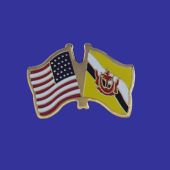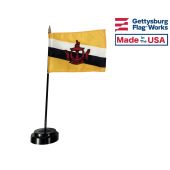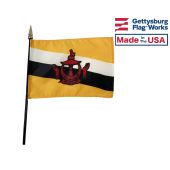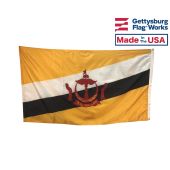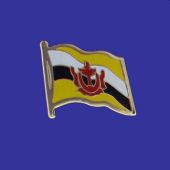Flag of Brunei
Flag of Brunei
Like many other flags, the Brunei flag stands for both the nation itself and the sultan that rules over it. It has changed a few times to account for changes in the national government, but the flag's design has remained remarkably stable over the years. Brunei is even one of the few nations to gain full political independence from the British empire without adopting a new flag to commemorate the event.
The national flag of Brunei was adopted in 1959 when the country was a British protectorate, and was retained when the country gained full independence on 1 January 1984 as Brunei Darussalam (State of Brunei, Abode of Peace). The flag has the coat of arms of Brunei in the centre, on a yellow field. The field is cut by black and white diagonal stripes, although they are officially called parallelograms.
The coat of arms is as follows: a crescent (symbolising Islam) joined with a parasol (symbolising monarchy), and two gloves on both sides. Below the crescent is a ribbon. On the crescent and ribbon are Arabic inscriptions translating as "State of Brunei, Abode of peace" and Brunei's motto, "Always in service with God's guidance" In Southeast Asia, yellow is traditionally the colour of royalty, and the royal standards of Malaysia and Thailand, along with the presidential flag of Indonesia, also use a yellow field.
Black and white stripes represent Brunei's chief ministers, and yellow represents the Sultan of Brunei. The national emblem was placed in the center in 1959. A similar version of this flag, without the coat of arms, was first used in 1906. The coat of arms bears a crescent symbolic of the Islamic faith, and the central mast is a symbol of the state. The flag and umbrella are symbols of royalty, and the upturned hands signify the benevolence of the government. The Arabic motto on the crescent translates as, Always render service by God's guidance. Below it, a scroll bears the inscription Brunei Darussalam, the country's official title, meaning City of Peace.
- Capital of Brunei: Bandar Seri Begawan
- Area of Brunei: 5,270 sq. km
- Languages used in Brunei: Malay (official), English, Chinese
- Religions in Brunei: Muslim, Buddhist, Christian, indigenous beliefs
Colors and Symbolism of the Brunei Flag
The Brunei flag features the nation's crest and a pair of black and white diagonal stripes on a yellow field. Yellow traditionally represents royalty in Brunei, which made it the natural choice for a flag that had to represent both the ruler and his nation. The stripes represent the two chief ministers of Brunei who advise the sultan and serve as regents when he is unable to rule. The crest combines a crescent moon that represents Islam with a parasol that represents the monarchy and open hands that represent the government's kindness and benevolence.
History of the Brunei Flag
The oldest known flag of Brunei was a solid yellow field without any sort of emblem on it. Brunei adopted a precursor to the modern flag in 1906, when it became a protectorate of the British empire. The new Brunei flag featured the same yellow field and pair of stripes as the modern flag, but it did not include the nation's crest. The crest was only added to the flag in 1959, which was the same year that the country adopted a new constitution. Brunei gained full independence from Britain in 1984, but unlike many other nations it did not adopt a new flag at the same time. It simply retained the flag that had represented it for two and a half decades and that still represents it today.
